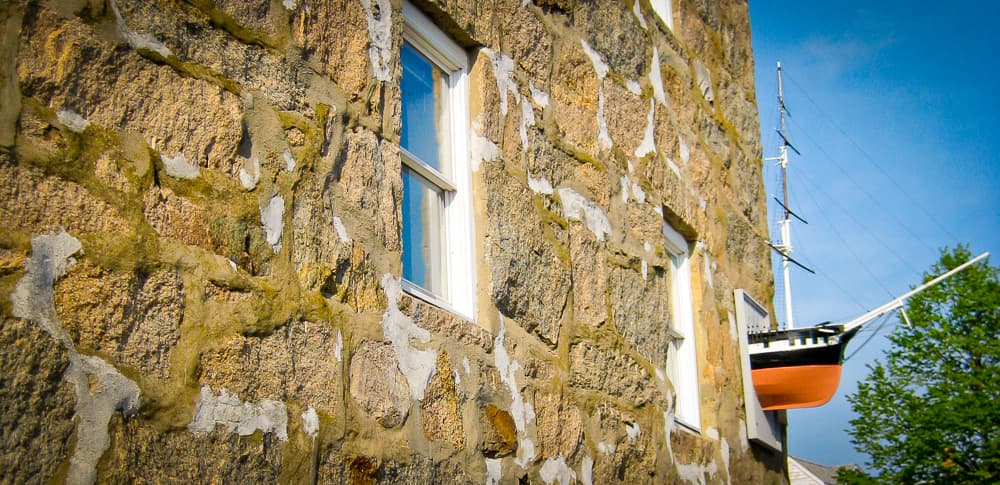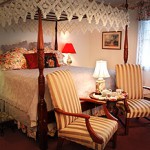Cape Cod Activities: The Historic Candle House in Woods Hole
The Candle House, built in 1829, is a great historic stop, even if it’s just to admire the stonework from the outside. The Candle House is all that remains of mid-nineteenth-century whaling in Woods Hole. It was part of a series of structures where whale oil was rendered. Today the Candle House is used by the Marine Biological Laboratory (MBL) for offices and is frequently used to display some of the exhibits for the annual Model Boat Show (another great Cape Cod activity).
Whaling in Woods Hole
Woods Hole in the 1700 and 1800’s was a quiet and relatively unsettled spot on the South Western corner of Cape Cod.
“These quiet, rural conditions, devoid of adventure, persisted until about 1815, when Woods Hole became an important whaling station from which ships operated on the high seas. The whaling industry in the United States became a very profitable business, and Woods Hole was a part of it. In 1854, the total receipts for the American whaling fleet amounted to $10.8 million, the largest part of this amount resulted from whaling carried out by Massachusetts captains. Woods Hole participated in these activities and prospered. It is known that between 1815 and 1860, not less than nine whaling ships were making port at the Bar Neck wharf, which was located where the U. S. Navy building of the Woods Hole Oceanographic Institution now stands. The place was busy processing oil and whalebone and outfitting ships. A bake house for making sea biscuits for long voyages stood next to the present “Old Stone Building” built in 1829 as a candle factory. This conspicuous old landmark on Water Street of Woods Hole, identified by an appropriate bronze plaque, has since served as a warehouse and more recently as executive and administrative offices for the MBL.” – www.nefsc.noaa.gov/history/stories/whistory.html
The Candle House and Spermaceti Production

Candle House
Spermaceti is a wax that is found in the head cavities of the sperm whale. After killing the whale, the whalers would sever the head, pull it on deck and cut a hole in order to bail out the matter. The primary source of the oil is from the spermaceti organ. This matter was boiled and strained of impurities to prevent the oil from going rancid. A large whale could yield as much as 500 gallons (en.wikipedia.org/wiki/Spermaceti). The raw spermaceti would then be stored in casks and brought back to Woods Hole for processed on land in buildings like the Candle House.
At the Candle House the casks were allowed to chill during the winter. The spermaceti would congeal into a spongy and viscous mass. This mass could then be placed into wool sacks and pressed. The resulting liquid was bottled and sold as the mos valuable spermaceti product – “Winter-Strained Sperm Oil,” an oil that remained liquid in freezing temperatures. In the warmer seasons, the left over spermaceti was allowed to partially melt, and the liquid was strained off to leave a fully solid wax. This was bleached and sold as “Spermaceti Wax.”
Whaling on the Atlantic
“American sperm whaling soon spread from the east coast of the American colonies to the Gulf Stream, the Grand Banks, West Africa (1763), the Azores (1765) and the South Atlantic (1770s). From 1770 to 1775 Massachusetts, New York, Connecticut, and Rhode Island ports produced 45,000 barrels of sperm oil annually, compared to 8,500 of whale oil. In the same decade the British began sperm whaling, employing American ships and personnel. By the following decade the French had entered the trade, also employing American expertise. Sperm whaling increased until the mid-19th century, as spermaceti oil was important in public lighting (for example, in lighthouses, where it was used in the United States until 1862, when it was replaced by lard oil, which was quickly replaced by petroleum) and for lubricating the machines (such as those used in cotton mills) of the Industrial Revolution. Sperm whaling declined in the second half of the 19th century, as petroleum and other products began to replace spermaceti.” – en.wikipedia.org/wiki/Sperm_whaling
Other Great Cape Cod Activities to Look into While in Woods Hole Include:
- Woods Hole Scientific Aquarium
- Ocean Quest
- Woods Hole Fishing Derby
- Favorite Walks on the Cape
- Woods Hole’s Rachel Carson
- Woods Hole Historical Museum Model Boat Show
- Shining Sea Bikeway (a brilliant ride from the Palmer House to Woods Hole)
The Palmer House Inn is located just a couple of miles from the village of Woods Hole. While all of our rooms have their own individual charm suitable for relaxation after the most wonderful day of adventures, we recommend the Harriet Beecher Stowe room or the Emily Dickinson room. Both rooms feature comfortable king beds, fireplaces, jetted tubs and a relaxing stay before and after your sea-going adventures.
Notes
http://www.whoi.edu/page/live.do?pid=20255&tid=441&cid=37870&ct=61&article=20986
http://www.whoi.edu/page.do?pid=9299
http://mysite.du.edu/~ttyler/ploughboy/starbuck.htm#sectiond




